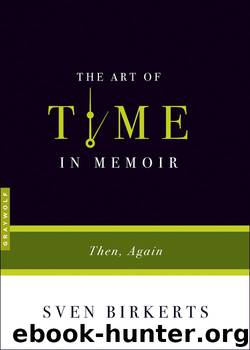The Art of Time in Memoir by Sven Birkerts

Author:Sven Birkerts
Language: eng
Format: epub
ISBN: 978-1-55597-339-1
Publisher: Graywolf Press
Published: 2014-04-10T04:00:00+00:00
Wolff’s opening, while obviously very different, follows the same structural logic as Conroy used with the night-driving scene. He creates a time frame, a platform outside the main narrative, and he introduces suspense, promising a certain dark revelation even as he creates the eventual possibility of closure. Indeed, as Conroy finishes Stop-Time by returning to the Jaguar speeding through the English countryside, so Wolff will return to the Narragansett house when his telling is done.
His mystery—to return to the Auster comparison—is psychological. On the obvious level, we ask: “Why would Wolff respond like this?” But in a deeper way, the whole account is a kind of extended, at times anguished, marveling at the strangeness of this dangerously driven man. Auster had next to nothing to go on—his father was, as he named him, an “invisible man.” Wolff, by contrast, has a superabundance of material. His father, Arthur, known to all as “Duke,” was, as the moniker suggests, larger than life. Only not in a heroic way, but with a dark twist. He was, top to bottom, start to finish, a deceiver, a liar, a con man.
Wolff can’t resist a few staged flourishes to introduce his father, and his point. Rather than just announcing what will soon enough be overwhelmingly obvious, he creates a seduction routine. First: “My father, called Duke, taught me skills and manners; he taught me to shoot and to drive fast and to read respectfully and to box and to handle a boat and to distinguish between good jazz music and bad jazz music…. His codes were not novel, but they were rigid, the rules of decorum that Hemingway prescribed. A gentleman kept his word, and favored simplicity of sentiment; a gentleman chose his words with care, as he chose his friends.” And so on. Then: “After Yale—class of late nineteen-twenty something, or early nineteen-thirty something—my father batted around the country, living a high life in New York among school and college chums, flying as a test pilot, marrying my mother, the daughter of a rear admiral…. Later he transferred to the OSS, and was in Yugoslavia with the partisans; just before the Invasion he was parachuted into Normandy, where he served as a sapper with the Resistance, which my father pronounced ray-zee-staunce.”
He takes considerable care to set us up with an appealingly detailed and credulously presented portrait of his father—several pages worth—and then, with no warning, he punctures the whole pretense. All it takes are three quick jabs of the pin: “A pretty history for an American clubman. Its fault is that it was not true. My father was a bullshit artist.”
With this, things get interesting. Now we have our first inkling of what that “Thank God” was about. What’s more, we are provoked, enlisted, on two different levels as readers. On the one hand we are intrigued by the man himself—outsized, compulsive, clearly a character. On the other, we can’t help but wonder at the author’s experience. What was his life with his father like
Download
This site does not store any files on its server. We only index and link to content provided by other sites. Please contact the content providers to delete copyright contents if any and email us, we'll remove relevant links or contents immediately.
Asking the Right Questions: A Guide to Critical Thinking by M. Neil Browne & Stuart M. Keeley(5356)
Autoboyography by Christina Lauren(5086)
Dialogue by Robert McKee(4160)
Eat That Frog! by Brian Tracy(4149)
Sticky Fingers by Joe Hagan(3911)
Journeys Out of the Body by Robert Monroe(3460)
Annapurna by Maurice Herzog(3298)
Full Circle by Michael Palin(3268)
Elements of Style 2017 by Richard De A'Morelli(3235)
Schaum's Quick Guide to Writing Great Short Stories by Margaret Lucke(3187)
The Art of Dramatic Writing: Its Basis in the Creative Interpretation of Human Motives by Egri Lajos(2857)
The Diviners by Libba Bray(2800)
Why I Write by George Orwell(2773)
The Mental Game of Writing: How to Overcome Obstacles, Stay Creative and Productive, and Free Your Mind for Success by James Scott Bell(2766)
In Patagonia by Bruce Chatwin(2755)
Atlas Obscura by Joshua Foer(2705)
The Fight by Norman Mailer(2700)
Venice by Jan Morris(2430)
The Elements of Style by William Strunk and E. B. White(2377)
